Ruellia L.
Mexican petunia, Mexican bluebell, Britton's wild petunia, wild petunia, creeping ruellia, ruellia
Acanthaceae
Alternanthera, Gratiola, Hygrophila, Hypericum, Mimulus
tropical to temperatetemperate:
(adj) of the climatic zone between boreal and tropical
regions worldwide; mainly Mexico, western South America, and the Antilles
the wild type ‘aquatic’ is rarely offered; typically only varieties of R. brittoniiana and hybrids are cultivated
Ruellia brittoniana Leonard
Ruellia simplex C.Wright is introduced into North America, Australia and Asia.
can be weedy along water courses
terrestrialterrestrial:
(adj) growing on land as opposed to living in water
, some amphibiousamphibious:
(adj) of a plant able to live on land or in water
herbs or shrubs
Medium to large erect herb. Rhizomatousrhizomatous:
(adj) possessing rhizomes
; stem erect, less often decumbentdecumbent:
(adj) (of stems) having a portion lying along the ground, with upper parts erect or ascending
 , often with nodal swellings, young stems ± square, older ones semi-woody, glabrousglabrous:
, often with nodal swellings, young stems ± square, older ones semi-woody, glabrousglabrous:
(adj) without hairs or scales
or puberulentpuberulent:
(adj) minutely pubescent
, green or purple. Leaves oppositeopposite:
(adj) (of leaves) two leaves per node; in pairs on opposite sides of an axis
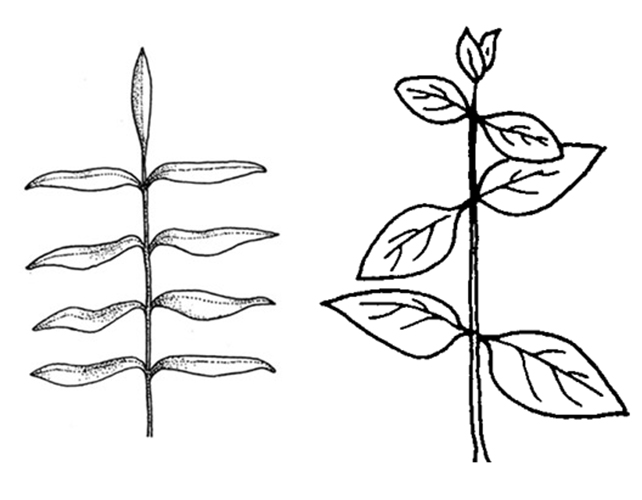 , decussatedecussate:
, decussatedecussate:
(adj) arranged along stem in pairs, with each pair at right angles to the pairs above and below
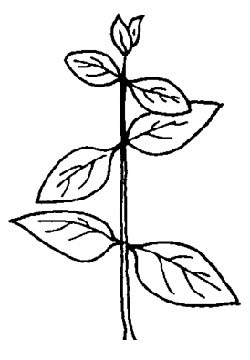 ; sessilesessile:
; sessilesessile:
(adj) attached directly, without a stalk
 or petiolatepetiolate:
or petiolatepetiolate:
(adj) relating to or in the form of a petiole; bearing petioles
; leaf bladeblade:
(n) (syn. lamina) the flat, expanded part of a leaf, frond, or petal (excluding, e.g., the petiole)
 linear to lanceolatelanceolate:
linear to lanceolatelanceolate:
(adj) lance-shaped; widest point below the middle, tapering to the apex
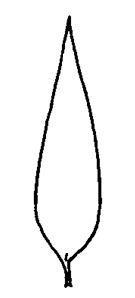 ; apexapex:
; apexapex:
(n) the point farthest from the point of attachment; the tip (often pointed)
acute or acuminateacuminate:
(adj) tapering gradually to a point and forming more or less concave sides
 ; margins entireentire:
; margins entireentire:
(adj) having a continuous margin that is not toothed or lobed
 ; veins prominent below; dark green. Inflorescenceinflorescence:
; veins prominent below; dark green. Inflorescenceinflorescence:
(n) the arrangement of flowers on the floral axis
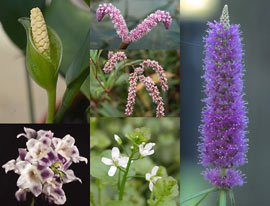 a terminalterminal:
a terminalterminal:
(adj) at the apex
or typically axillaryaxillary:
(adj) in, of, or produced from an axil
cymecyme:
(n) a determinate, usually flat-topped or convex inflorescence in which the terminal flower blooms earliest
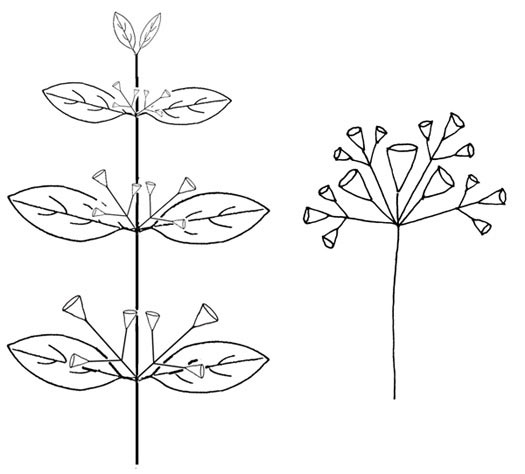 or occasionally a solitary flower; bracts inconspicuous, oppositeopposite:
or occasionally a solitary flower; bracts inconspicuous, oppositeopposite:
(adj) (of leaves) two leaves per node; in pairs on opposite sides of an axis
 , linear, usually green; bracteoles 2 or absent; pedicellatepedicellate:
, linear, usually green; bracteoles 2 or absent; pedicellatepedicellate:
(adj) borne on a pedicel
or sessilesessile:
(adj) attached directly, without a stalk
 ; blue to purple, cultivated forms white or pink. Calyxcalyx:
; blue to purple, cultivated forms white or pink. Calyxcalyx:
(n) the outer whorl of the perianth; all the sepals of a flower
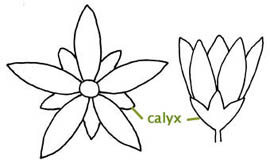 deeply 5-lobed, lobes linear or lanceolatelanceolate:
deeply 5-lobed, lobes linear or lanceolatelanceolate:
(adj) lance-shaped; widest point below the middle, tapering to the apex
 , ± equal; corollacorolla:
, ± equal; corollacorolla:
(n) the inner whorl(s) of the perianth; all the petals of a flower
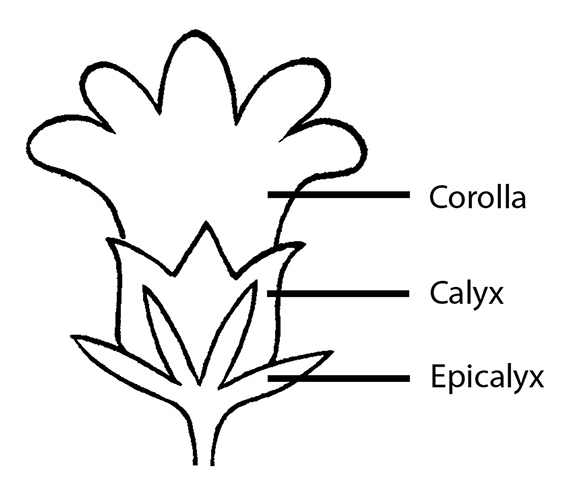 trumpet or salver-shaped, cylindricalcylindrical:
trumpet or salver-shaped, cylindricalcylindrical:
(adj) forming a nearly true cylinder
below, limblimb:
(n) the expanded portion of a petal or bract (e.g., a spathe)
spreading, subequally 5-lobed, lobes usually ovateovate:
(adj) egg-shaped in outline; generally with the broad end at or near the base
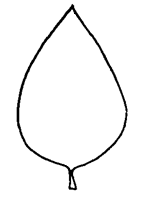 to orbicularorbicular:
to orbicularorbicular:
(adj) circular in outline
 , apexapex:
, apexapex:
(n) the point farthest from the point of attachment; the tip (often pointed)
obtuseobtuse:
(adj) with a blunt or rounded apex and sides coming together at an angle of more than 90 degrees
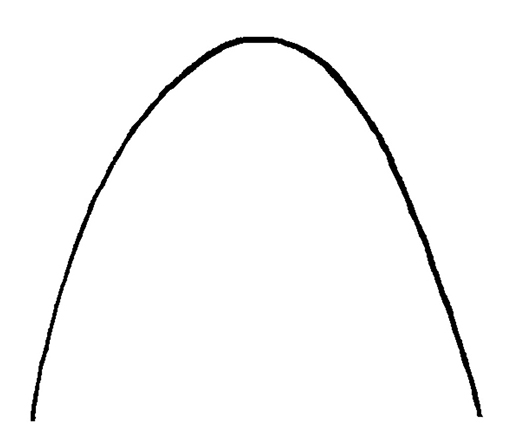 ; stamens 4, filaments sometimes connateconnate:
; stamens 4, filaments sometimes connateconnate:
(adj) of plant parts congenitally united into a single structure
in pairs at base, anthers oblongoblong:
(adj) two to four times longer than wide, with +/- parallel sides
 , staminodestaminode:
, staminodestaminode:
(n) a sterile stamen, not producing pollen; may be inconspicuous, petaloid, or showy
1 or absent; stylestyle:
(n) in a flower, the narrow and elongated part of the pistil between the stigma and the ovary
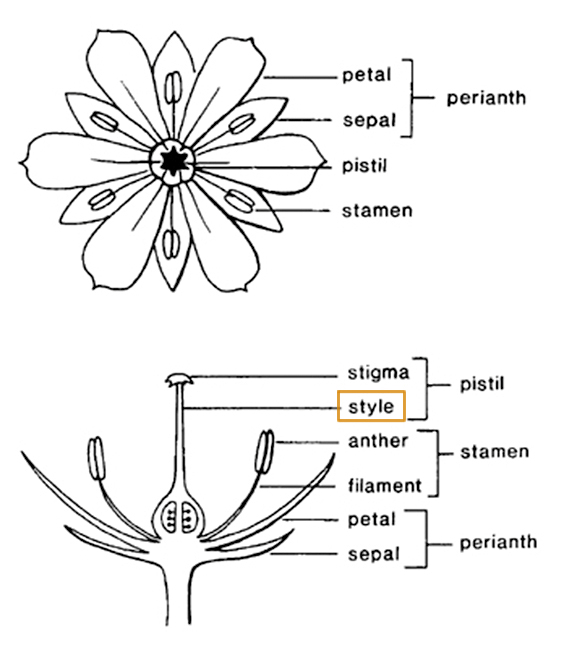 usually included, stigmastigma:
usually included, stigmastigma:
(n) the portion of the pistil that is receptive to pollen
unequally 2-lobed.
wide variety of habitats; moist to marshy/wet areas, wetlands, riparianriparian:
(adj) growing by rivers or streams; of, adjacent to, or living on, the banks of a river, lake, pond, etc.
vegetation, disturbed sites, drainage ditches, shores of waterways (ponds, lakes, rivers), moist to wet wooded areas; while productive in wet habitats, has a high drought tolerance
A genus consisting of over 250 species, of which only a few are tolerant of very wet conditions, and often become very weedy in some places. Ruellia brittoniana is often offered as an aquarium or pond plant because it tolerates short periods submergedsubmerged:
(adj) (syn. submersed) under water; submerged below the water surface
, though it needs to grow as an emersedemersed:
see emergent
plant.